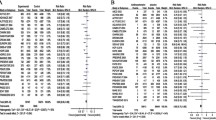Abstract
Background and objective: While a number of conditions and risk factors that increase stroke risk have been identified, arterial hypertension is the most consistent and powerful predictor. The angiotensin II type 1 receptor antagonist (angiotensin receptor blocker [ARB]) losartan has been shown in the LIFE (Losartan Intervention for Endpoint Reduction in Hypertension) study to decrease stroke risk in hypertensive patients to a substantially greater extent than conventional therapy. We aimed to assess the impact of the blood pressure-lowering effect of losartan therapy on stroke risk in hypertensive patients in primary care.
Methods: A total of 2977 primary-care practices throughout Germany included 22 499 consecutive unselected patients with a confirmed diagnosis of hypertension in an open-label, prospective, observational study. In addition to demographics, known risk factors for stroke were documented on standardised questionnaires. The 10-year predicted risk of first stroke was calculated according to the Framingham Stroke Risk Score at baseline and after a mean of 94 ± 24 days of losartan (± hydrochlorothiazide [HCTZ]) therapy.
Results: The mean patient age was 64.1 ± 10.6 years, and 52.4% were males. Mean systolic/diastolic blood pressure decreased from 160 ± 15/93 ± 9mm Hg at baseline by −21 ± 14/−11 ± 9mm Hg. Besides hypertension, 84.9% of patients had other co-morbidities, of which the most frequent were hypercholesterolaemia (53.0%), diabetes mellitus (36.1%), coronary heart disease (31.1%) and left ventricular hypertrophy (24.2%). The average predicted 10-year stroke risk was 28.0 ± 21.9% at baseline, and 22.1 ± 19.5% at study end (relative risk reduction 24 ± 16%, p < 0.05). In subgroups of patients with diabetes or nephropathy, similar effects were noted. Drug-related adverse events were reported in 18 patients; all of these were non-serious.
Conclusion: Because of the high prevalence of co-morbidities and risk factors, the hypertensive patient population observed in this study presented with a high 10-year stroke risk. Treatment with losartan (± HCTZ) was well tolerated and led to a substantial decrease in blood pressure and associated stroke risk.





Similar content being viewed by others
Notes
The use of trade names is for product identification purposes only and does not imply endorsement.
References
Murray CJ, Lopez AD. Alternative projections of mortality and disability by cause 1990–2020: Global Burden of Disease Study. Lancet 1997; 349(9064): 1498–504
Goldstein LB, Adams R, Alberts MJ, et al. Primary prevention of ischemic stroke: a guideline from the American Heart Association/American Stroke Association Stroke Council. Stroke 2006; 37: 1583–633
Kjeldsen SE, Julius S, Hedner T, et al. Stroke is more common than myocardial infarction in hypertension: analysis based on 11 major randomized intervention trials. Blood Press 2001; 10(4): 190–2
D’Agostino RB, Wolf PA, Belanger AJ, et al. Stroke risk profile: adjustment for antihypertensive medication. The Framingham Study. Stroke 1994; 25(1): 40–3
Moen MD, Wagstaff AJ. Losartan: a review of its use in stroke risk reduction in patients with hypertension and left ventricular hypertrophy. Drugs 2005; 65(18): 2657–74
Institut für Praxisforschung (PRAFO) im BDA [online]. Available from: http://www.hausarzt-bda.de/private/020/040/pravo.html [Accessed 2006 Jul 12]
Dahlof B, Devereux RB, Kjeldsen SE, et al. Cardiovascular morbidity and mortality in the Losartan Intervention For Endpoint reduction in hypertension study (LIFE): a randomised trial against atenolol. Lancet 2002; 359(9311): 995–1003
Kizer JR, Dahlof B, Kjeldsen SE, et al. Stroke reduction in hypertensive adults with cardiac hypertrophy randomized to losartan versus atenolol: the Losartan Intervention For Endpoint reduction in hypertension study. Hypertension 2005; 45(1): 46–52
Ferrario CM. The role of angiotensin antagonism in stroke prevention in patients with hypertension: focus on losartan. Curr Med Res Opin 2004; 20(11): 1797–804
Guidelines committee. European Society of Hypertension-European Society of Cardiology guidelines for the management of arterial hypertension. J Hypertens 2003; 21: 1011–53
International Diabetes Federation. Hypertension in people with type 2 diabetes: knowledge-based diabetes-specific guidelines. Diabet Med 2003; 20(12): 972–87
Chobanian AV, Bakris GL, Black HR, et al. The seventh report of the Joint National Committee on Prevention, Detection, Evaluation, and Treatment of High Blood Pressure: the JNC 7 report. J Am Med Ass 2003; 289(19): 2560–71
Hasford J, Mimran A, Simons W. A population-based European cohort study of persistence in newly diagnosed hypertensive patients. J Hum Hypertens 2002; 16(8): 569–75
Law MR, Wald NJ, Morris JK, et al. Value of low dose combination treatment with blood pressure lowering drugs: analysis of 354 randomised trials. Brit Med J 2003; 326(7404): 1427–31
Pittrow D, Kirch W, Bramlage P, et al. Patterns of antihypertensive drug utilization in primary care. Eur J Clin Pharmacol 2004; 60(2): 135–42
Concato J, Shah N, Horwitz RI. Randomized, controlled trials, observational studies, and the hierarchy of research designs. N Engl J Med 2000; 342(25): 1887–92
Acknowledgements
This study was presented at the Fifteenth European Hypertension Meeting on Hypertension in Milan, Italy, on 17 June 2005. The study was supported by an unrestricted educational grant from MSD Sharp & Dohme GmbH and Chibropharm GmbH, Haar/Munich, Germany.
Dr Bestehorn is an employee of MSD, and is also affiliated with the Medical Faculty of the Technical University of Dresden, Germany. Dr Wahle has no conflicts of interest that are directly relevant to the content of this study. The authors acknowledge the input of D. Pittrow, MD, PhD, Dresden/Munich, to the interpretation of the study.
Author information
Authors and Affiliations
Corresponding author
Rights and permissions
About this article
Cite this article
Bestehorn, K., Wahle, K. Impact of Losartan on Stroke Risk in Hypertensive Patients in Primary Care. Clin. Drug Investig. 27, 347–355 (2007). https://doi.org/10.2165/00044011-200727050-00006
Published:
Issue Date:
DOI: https://doi.org/10.2165/00044011-200727050-00006




